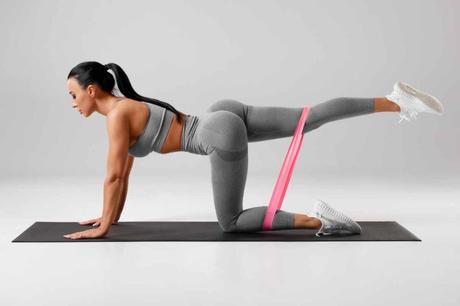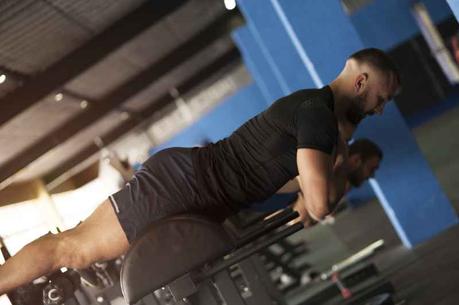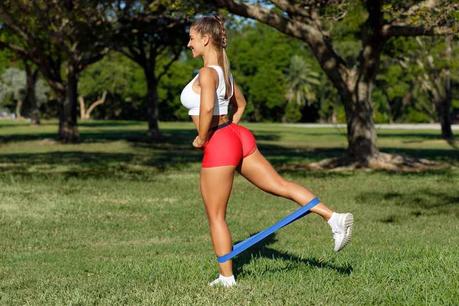Strong glutes not only look great, they are also highly functional. Here are the best glute exercises for a stronger booty. Buckle up for glute gains!

Training your glutes isn’t just about getting that “cake” you want.
It’s about building a stronger core and foundation to ensure your lower body can move efficiently and provide support for your upper body.
It’s no exaggeration to say that you should spend as much time training your glutes as you do any of the other smaller muscle groups in your body—including your biceps, triceps, abs, and lower back.
The more you train your glutes—not just using strength-building movements, but also glute stretches to increase flexibility—the more mobile and powerful you will become!
In this guide, I’ll break down my favorite glute exercises for a stronger booty, why you should spend time at the gym training your behind, and more.
- Why You Should Do Glute Exercises at the Gym
- The Best Glute Exercises for a Stronger Behind
- Sample 20-Minute Glute Workout
- Best Glute Exercises – FAQs
Let’s jump in and unleash some serious booty gains.
Why You Should Do Glute Exercises at the Gym
There are a number of excellent reasons that you should include regular glute training in your lower body workouts, including:
 Reason #1: You’ll Increase Muscular Power
Reason #1: You’ll Increase Muscular Power

Your glutes are involved in literally every leg movement—running, jumping, squatting, lunging, sitting down, standing up, even bending over. Having strong glutes is crucial for building a solid foundation in your legs.
More glute power equals more thrusting, squatting, standing, and clenching power, which translates into better lunges, squats, deadlifts, and even standing raises.
Fun Fact: The glutes are the largest and most powerful muscles in the body1.
 Reason #2: You Improve Back Strength
Reason #2: You Improve Back Strength

Your glutes work together with your lower back to move your body. When you lift, squat, lunge, or run, your glutes play a significant role in stabilizing your lower body while your spinal muscles stabilize your upper body.
Your glutes also assist in any motion in your trunk, pelvis, and hips, and help to ensure any load on your upper body is evenly distributed through the base of your body (your legs).
Stronger glutes provide better back support, which reduced your risk of back injury.
 Reason #3: You Increase Knee Resilience
Reason #3: You Increase Knee Resilience

When your glutes (and leg muscles) aren’t strong enough for a lift, your body tries to compensate by flaring your leg outward to engage your hip muscles.
But this can put a strain on your knees and increase your risk of knee injury.
Glute training, however, ensures your legs have sufficient power to make those heavy lifts while still maintaining proper form.
It will make your knees stronger, reduce injury risk, and facilitate easier, more natural movement of the joint.
 Reason #4: You Improve Your Posture and Balance
Reason #4: You Improve Your Posture and Balance

As mentioned above, your glutes work with your lower back muscles to ensure there is ample support for any weight on your upper body.
That includes, of course, the weight of your upper body (even unloaded). Poor posture is typically a side effect of weak muscles—when you grow tired, you tend to hunch and lean forward, which can impair your balance.
But training your glutes helps to build the power your body needs to maintain that good posture, and will provide stability that improves your balance significantly.
 Reason #5: It Looks Good
Reason #5: It Looks Good

Bigger, stronger glutes are also more well-rounded and attractive glutes, too!
As you can see, there are plenty of great reasons it’s worth investing your time into glute training.
The Best Glute Exercises for a Stronger Behind
 Exercise #1: Glute Ham Raise
Exercise #1: Glute Ham Raise

The glute ham raise is an ideal exercise for anyone who wants to target both their glutes and hamstrings in one highly effective exercise.
The GHD machine recruits both of these posterior chain muscles along with your lower back, leading to better posterior chain strength and support for your upper body.

To perform this exercise:
- Mount the GHD machine with your feet pressed against the toe plate and the thigh pad set to roughly mid-thigh.
- Grab a medicine ball, barbell plate, or use only bodyweight, as you are capable.
- Keeping your back perfectly straight, lower your upper body toward the floor. Stop once you are slightly below parallel to the floor—this maximizes glute engagement and takes the focus off the lower back.
- Using only the strength in your hamstrings and glutes, raise yourself back up to near vertical position. Slide your thighs along the pad and bend your knees to facilitate smooth movement.
- Pause at the top for a 1-count, then repeat as desired.
 Exercise #2: Barbell Glute Bridge
Exercise #2: Barbell Glute Bridge

If you’ve got a special glute bridge/hip thruster machine at the gym, this is one of the best exercises you can do.
However, you can perform it even with a barbell or a few weight discs.
What matters is that you maximize glute engagement and strengthen these critical muscles with a highly effective thrusting movement.
To perform this exercise:
- Sit on the floor with your upper back resting against a bench, and a barbell resting on your lap.
- Use a hip thrust pad to protect your pelvis from the weight of the barbell. Or, if you have a glute bridge/hip thruster machine, load it up and strap it tight across your lap.
- Place your feet flat on the floor with your knees bent.
- Thrust your hips toward the sky slowly and with controlled, smooth movement.
- Thrust as high as you can, aiming to form a tabletop with your body.
- Focus on contracting your glutes at the top of the exercise, really squeezing those muscles tight.
- Lower slowly and under control once more, but stop just before you touch the ground (rest point).
- Thrust upward again, and repeat as desired.
 Exercise #3: Side Squats
Exercise #3: Side Squats

Side squats are one of my favorite glute band exercises because they encourage more effective movement in a natural position.
It also exchanges barbells and dumbbells for resistance bands, which allows you to customize the focus of the workout according to the muscles you want to target.
You’ll find it’s one of the best glute-focused squat variations around and will do wonders to improve hip mobility.
To perform this exercise:
- Stand in a comfortable position with your feet roughly shoulder width apart, back straight, head up.
- Secure a resistance band to your legs, just below your knees.
- Inhale deeply and bend your knees to lower into a squatting position.
- Step your right foot out to the right, then back inward.
- Step your left foot out to the left, then bring it back to your starting position.
- Repeat 8-12 times per foot, until you feel the serious burn in your quads and glutes.
 Exercise #4: Walking Lunge
Exercise #4: Walking Lunge

The walking lunge is one of the all-time best lower body exercises because it builds strength through a full, natural range of motion.
Instead of simply lunging forward and stepping back (a fairly unnatural movement), it encourages you to step forward again and again, simulating walking (albeit with weight).
The walking lunge is one of the best exercises to build strength in your glutes, hips, lower quad muscles that support the knees, and the quads overall.
To perform this exercise:
- Start with your feet together in a comfortable stance, your back straight and your shoulders relaxed.
- Load a barbell on your shoulders, hold a pair of dumbbells or kettlebells, or perform this exercise using bodyweight alone.
- Step your right foot out in front of you, far enough that when you plant the foot, your right knee can bend far enough that your thigh is parallel to the floor before your left knee touches the floor.
- Tighten your glutes and core and propel off your back foot to step your left foot forward and place it next to your right foot.
- Now, step your left foot forward, lower into the lunge, and bring your right foot forward to place it beside your left foot. You have now completed one repetition.
- Repeat as desired.
 Exercise #5: Curtsy Lunge
Exercise #5: Curtsy Lunge

The curtsy lunge is an amazing exercise to train some of the lesser-used muscles along the outside of your legs, both on the front (quads) and back (hamstrings and glutes).
It’s also great for strengthening your knees and increasing lower body mobility overall.
It’s definitely an exercise you’ll want to start using only your bodyweight, and slowly increase your weight as your leg muscle power increases.
To perform this exercise:
- Start with your feet together in a comfortable stance, your back straight and your shoulders relaxed.
- Step your right foot backward and to the left, crossing it behind your left leg. Plant your foot so the toes of your right foot are in line with the heel of your back foot.
- Bend your knees to lower into a squat/lunge. Lower until your left thigh is roughly parallel to the floor and your right knee almost touches the floor.
- Push back up and return to your starting position, planting your feet side by side.
- Now step the left foot back and to the right, planting your left toes in line with your right heel.
- Lower into the squat/lunge position until your left knee almost touches the floor, then return to your starting position. You have now completed one repetition.
- Repeat as desired.
Trainer’s Note:
To really maximize glute focus, perform this like you would the Bulgarian split squat, with your rear foot elevated on a bench or box.
 Exercise #6: Kickback
Exercise #6: Kickback

The kickback is a simple yet highly effective option to focus on strengthening your glutes.
You can perform it using bodyweight alone, or add in an ankle weight or ankle strap for the cable machine to add some extra load on your leg as you lift it.
Training with a cable machine is awesome as you get increased time under tension, and using a leg machine at the gym is generally much safer compared to free weights.

Either way, it’s a great “finisher” for your glute training session.
To perform this exercise:
- Get on your hands and knees on a padded mat. Strap ankle weights or a cable ankle strap to your right ankle, or use your bodyweight alone.
- Without moving your upper body at all, lift your right knee from the mat and kick it directly backward and up as high as you can. Keep your leg in line with your body and use only your glutes to kick it upward.
- Contract at the top of your kick and focus on squeezing the glutes tight. Hold for a 1-count, then lower.
- Repeat as desired with your right leg, then an equal number with your left leg.
Sample 20-Minute Glute Workout
Time to put it all together into one highly effective workout session!
- Barbell Glute Bridge: 3 sets of 10-12 reps, with 30 seconds of rest between.
- Walking Lunges: 3 sets of 10-12 reps, with 30 seconds of rest between.
- Curtsy Lunges: 2 sets of 10-12 reps, with 30 seconds of rest between.
- Side Squats: 3 sets of 10-12 reps, with 30 seconds of rest between.
- Glute Ham Raises: 3 sets of 10-12 reps, with 30 seconds of rest between.
- Kickbacks: 2 sets of 10-12 reps, with 30 seconds of rest between.
Cap it off with a nice warm-down including some light active recovery and glute stretches for keeping your hips and glutes nice and loose.
Best Glute Exercises – FAQs
What exercise hits glutes the hardest?
The single-leg squat (or its variations, including single-leg split squat, pistol squat, and Bulgarian split squat) is the best for maximizing glute focus while also training your legs.
It will ensure that all of your lower body muscles (glutes, hamstrings, and quads) grow in power and stamina together.
The hip thrust is up there as well in terms of muscle activation. Hip thrusts have become intensely popular in local gyms, and for good reason, they are an absolute monster for building booty muscle mass.
How do I grow the bottom of my butt?
The ideal means of targeting the “underbutt” is to work both the glutes and hamstrings together, as these two muscles are what form the crease on the bottom of your butt.
Exercises like kickbacks and glute ham raises are absolutely spectacular for building a better-looking underbutt.
Can I train glutes everyday?
Like every other muscle in your body, your glutes need time to rest between training sessions in order to recover and build new/expand existing muscle fibers. You can train your glutes regularly, but make sure to give yourself at least 48 hours of rest between glute training sessions. That means no more than three glute workouts a week!
The Bottom Line
Your glutes are critical for your lower body strength and play a central role in posture, mobility, and joint resilience. It’s pretty clear why it’s important to take time to train them, then.
Thankfully, with the exercises above, you can maximize focus on your glutes and give these important muscles the love and attention they deserve.
Whether you include glute training at the end of your Leg Day session or take a whole day to train your glutes, just now that taking the time to strengthen the glutes is never wasted—it will just make you stronger in all the right ways.
More Glute Guides and Articles
6 Best Dumbbell Glute Exercises (Plus Benefits and How to Do Them Properly). Dumbbells are a killer way to take your glute training to the next level. Here’s a look at the best dumbbell glute exercises, including benefits and pro tips for doing them properly.
5 Hip Thrust Variations for Glute Strength. Looking for some ways to spice up the almighty hip thrust? Here are five hip thrust variations for developing maximum glute muscle and strength.
Hip Thrust vs Glute Bridge: Pros, Cons, Differences. While they look very similar, the hip thrust and the glute bridge are very different exercises targeting different muscles. Here’s a deeper look at the differences between these popular glute-building exercises.
